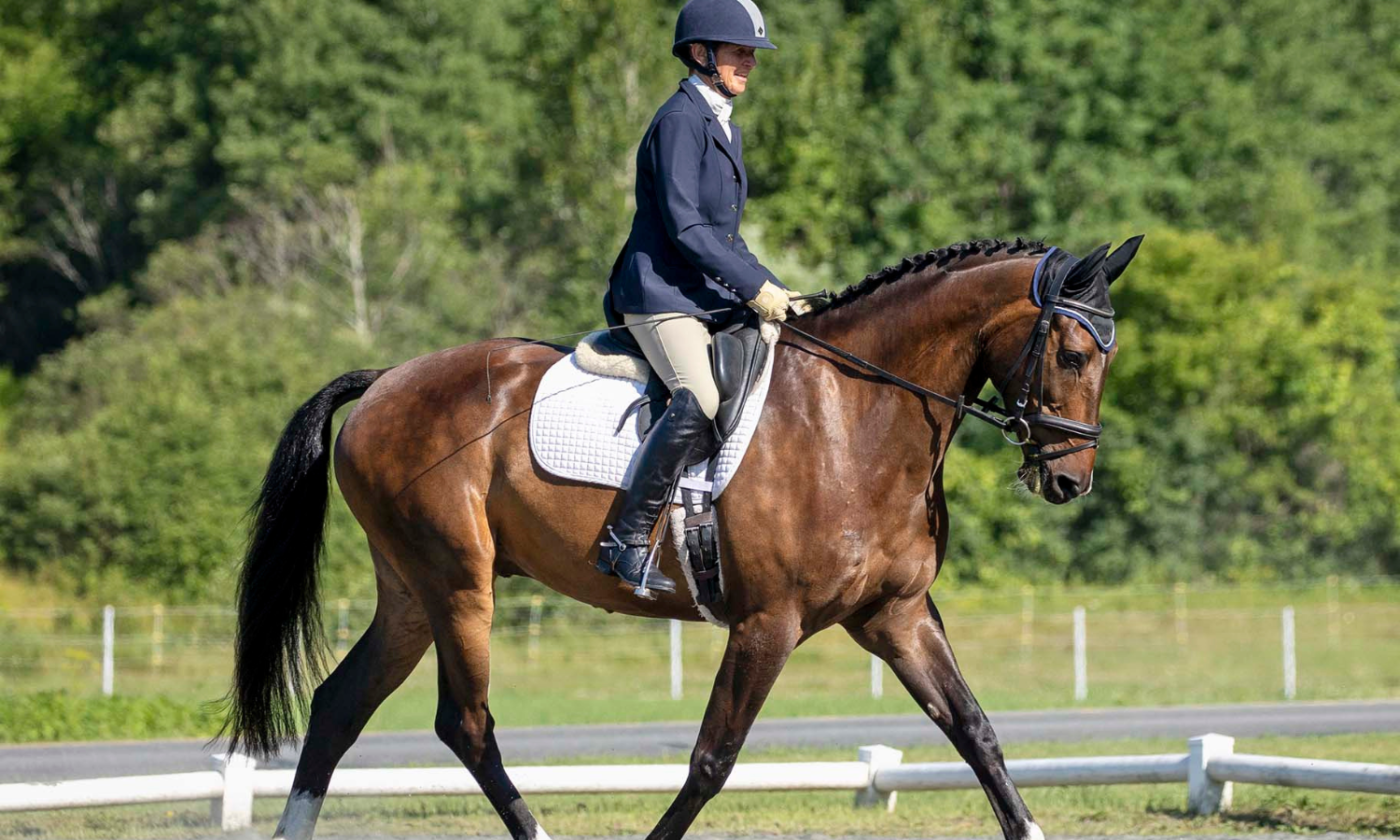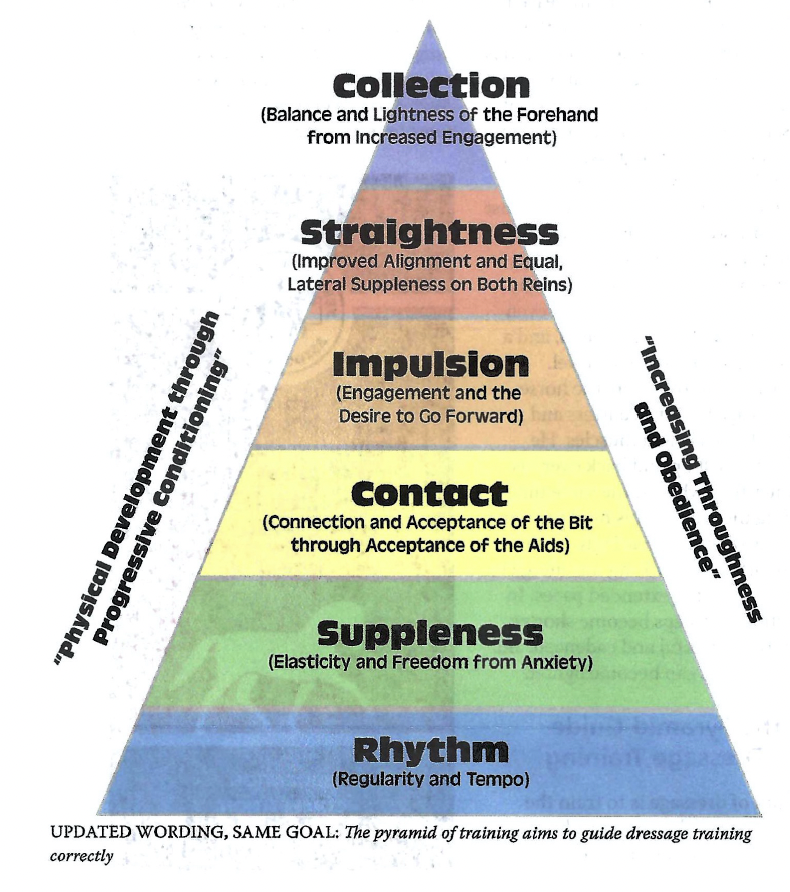Renew Your USEA Membership for the 2023 Season Today LEARN MORE

This article was originally published in Issue 4, 2023 of Eventing USA magazine.
You can use your dressage test sheet not only to learn your test but to see what the judges are looking for in each movement. You can find your dressage test on the USEA website (www.useventing.com) under the “Events + Competitions” menu, then “Resources,” then “Forms + Documents.” Each level has either two or three tests that can be ridden at the level you are competing at, so make sure you check which test is being used at the competition you’re riding at. It’s pretty disappointing to realize you’ve learned the wrong test after you turned the wrong way at “C.”
Pre-Competition Preparation
When you’re learning your test, look over to the next box after the movement, and you’ll see a box with the directives of each movement. This describes what the judges are looking for in each movement. Here are two examples to reference, one at the Novice level and one at the Intermediate level.
Block four in the Novice Test A reads: “Between C and H - Working canter left lead.” The directives for that movement state: “Willing, calm transition; quality and regularity of gaits; balance and bend in corner.” These are great words to think of when you are practicing that movement—a willing, calm transition, maintaining the quality and regularity of the gaits, and maintaining the bend through the corner. For that high score your horse steps off promptly and quietly into the canter when asked without rushing the trot into the canter. He stays in the correct bend throughout and proceeds in a quiet, balanced canter. It sounds easy, but it all takes practice.
Another example is Intermediate Test B, block five. The movement reads: “V Half circle left 10 meters to L- L Half pass left, returning to track between S and H.” The directives say: “Angle, bend and balance; fluency; crossing of legs; quality and engagement of trot; accuracy and geometry of figure.” That’s a ton of information! The judges are looking for bend in the half circle before the half pass, angle, bend, and balance in the half pass with fluid steps and crossing over of the legs. They want to see you maintain the quality of the trot with engagement while being accurate with correct geometry. This information helps you know what to practice and if there is any confusion with the movement, you can make sure to get help before going down the center line at the competition.
There are two great, free references you can access online to help define a word or better understand a movement. One is the USEF Rulebook. Look under the Dressage Division Rules in the section defining figures and movements—DR 109-DR112. This section explains exactly what the movement should look like according to the rules and will help clarify it in your mind. The other reference is the USDF Glossary of Judging Terms which can help you understand some of the descriptive words a judge uses. These are free resources with simple descriptions. Do your homework, and your scores will reflect the work that you’ve put in.
Another thing to look for on your test sheet is when one movement starts and another ends. It is helpful to know when the block begins and when the score for that block has ended. For example, use our above block four in the Novice A test. The block begins: “between C and H Working canter left lead,” but it doesn’t end until the next block starts. In this case, the next block starts at: “E- circle left 20 meters.” So after you’ve done your canter transition, you have to go straight down the long side to E where the next movement begins. This short period of time on the long side has an influence on your score in block four.
As judges, we are trained to look for the “essence” of the movement or the main focus of the movement, which in this case is the canter transition. The other parts of the movement such as the bit of canter to “E” where block five starts are known as the “modifier.” So the essence of block four is picking up the canter between C and H, but your modifier would be the canter down the long side until you get to E where block five starts. If you had a fabulous canter transition, but your horse had a big spook before E, it modifies your score in block four. The “essence” of the movement will have more influence on your score, but the modifier can bring the score up or down depending on how good or not good the complete movement is performed. You start all over with a new score for movement five. By knowing where one movement starts and another ends, you’ll know when you’re starting with a completely new score. Remember it’s not uncommon to have a low score in one movement and a high score for the next movement, so keep riding. One low score does not mean disaster for the whole test.

Post-Competition Review
Pick up your test score sheet! There's lots to learn from it, and you’ve paid for that information, so don’t leave it at the show even if it wasn’t your shining moment. Sometimes it’s a consistent problem you’re seeing in several tests in a row. For example, the judge doesn’t think you are going forward enough or you don’t have enough right bend. Sometimes it’s a technical flaw, such as not having enough angle in your shoulder-in or your 10-meter circle being too big. Sometimes it’s a major problem such as extreme tension and lack of throughness. It’s always helpful to read what the judges are seeing. They might say something in slightly a different way that will explain the score and help you for the next test. Judges want to see riders get better, and we love giving high scores!
Understand what the score means. In other words, a score of 4 is insufficient, and a score of 5 is marginal. If your score is below 5, there’s a problem. It might be as simple as your horse had a naughty moment, but it might mean there’s a problem with your understanding of a movement or more seriously a problem with your training. Make sure you share your test with your trainer so you can both assess what the judge has seen. If you’re consistently getting a low score either for a certain movement or over the whole test, it’s time to re-evaluate.
Finally, look at the final score, “Harmony of athlete and horse.” The directive says it is looking for “a confident partnership created by adhering to the scale of training.” This score should reflect the overall feeling the judge had about your test. Is your training going in the right direction? Are you presenting a harmonious picture with your horse? Is your horse happily answering your aids? Is your horse supple, relaxed, and soft? Use your test sheet ,and read what the judge has said. Try not to feel offended. Be honest and evaluate—it might be a one-off day, but if you consistently are getting the same remarks it’s time to rethink things. You and your horse will only benefit.
Did you enjoy this article? Want to receive Eventing USA straight to your mailbox? Members receive Eventing USA as part of their USEA Membership or you can purchase individual issues from the USEA Shop.